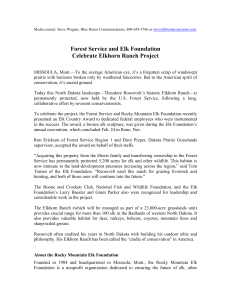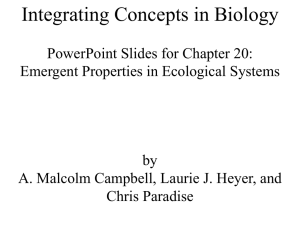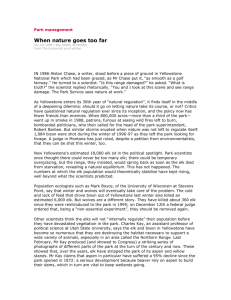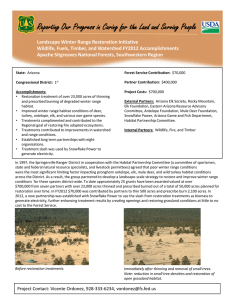PNW
advertisement
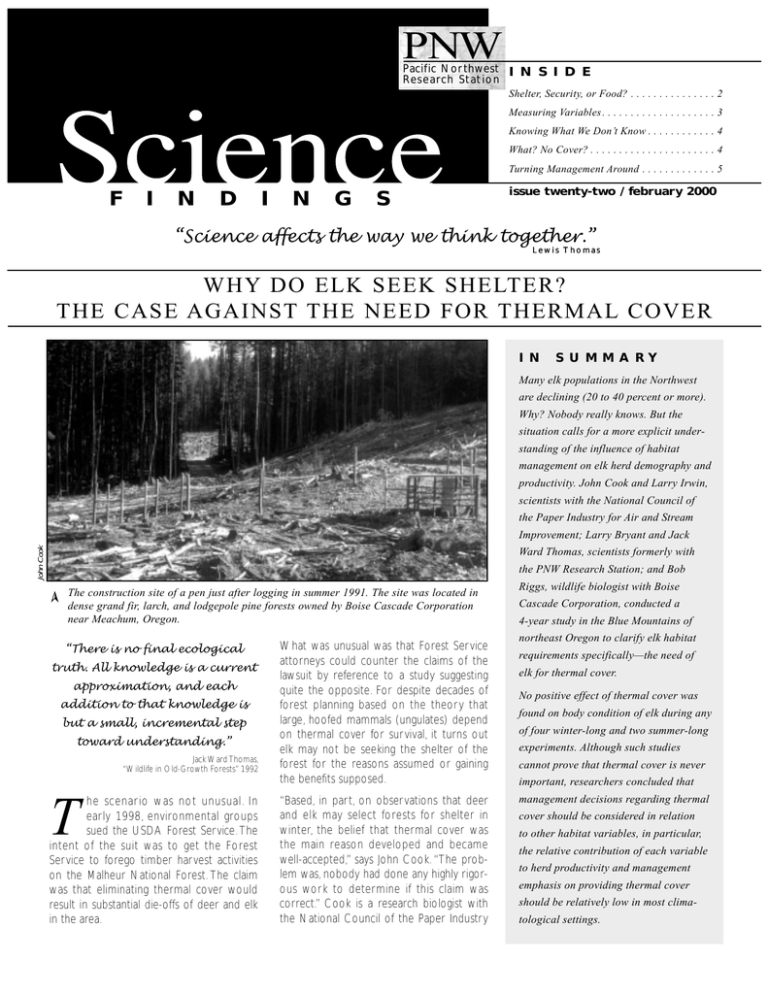
PNW Pacific Northwest I N S I D E Rese a rch Stat ion Shelter, Security, or Food? . . . . . . . . . . . . . . . 2 Measuring Variables . . . . . . . . . . . . . . . . . . . . 3 Knowing What We Don’t Know . . . . . . . . . . . . 4 What? No Cover? . . . . . . . . . . . . . . . . . . . . . . 4 Turning Management Around . . . . . . . . . . . . . 5 F I N D I N G S issue twenty-two / february 2000 “Science affects the way we think together.” Lewis Thomas WHY DO ELK SEEK SHELTER? THE CASE AGAINST THE NEED FOR THERMAL COVER I N S U M M A RY Many elk populations in the Northwest are declining (20 to 40 percent or more). Why? Nobody really knows. But the situation calls for a more explicit understanding of the influence of habitat management on elk herd demography and productivity. John Cook and Larry Irwin, scientists with the National Council of the Paper Industry for Air and Stream John Cook Improvement; Larry Bryant and Jack Ward Thomas, scientists formerly with ➢ the PNW Research Station; and Bob The construction site of a pen just after logging in summer 1991. The site was located in dense grand fir, larch, and lodgepole pine forests owned by Boise Cascade Corporation near Meachum, Oregon. “There is no final ecological truth. All knowledge is a current approximation, and each addition to that knowledge is but a small, incremental step toward understanding.” Jack Ward Thomas, “Wildlife in Old-Growth Forests” 1992 T he scenario was not unusual. In early 1998, environmental groups sued the USDA Forest Service. The intent of the suit was to get the Forest Service to forego timber harvest activities on the Malheur National Forest. The claim was that eliminating thermal cover would result in substantial die-offs of deer and elk in the area. What was unusual was that Forest Service attorneys could counter the claims of the lawsuit by reference to a study suggesting quite the opposite. For despite decades of forest planning based on the theor y that large, hoofed mammals (ungulates) depend on thermal cover for survival, it turns out elk may not be seeking the shelter of the forest for the reasons assumed or gaining the benefits supposed. “Based, in part, on observations that deer and elk may select forests for shelter in winter, the belief that thermal cover was the main reason developed and became well-accepted,” says John Cook. “The problem was, nobody had done any highly rigorous work to determine if this claim was correct.” Cook is a research biologist with the National Council of the Paper Industry Riggs, wildlife biologist with Boise Cascade Corporation, conducted a 4-year study in the Blue Mountains of northeast Oregon to clarify elk habitat requirements specifically—the need of elk for thermal cover. No positive effect of thermal cover was found on body condition of elk during any of four winter-long and two summer-long experiments. Although such studies cannot prove that thermal cover is never important, researchers concluded that management decisions regarding thermal cover should be considered in relation to other habitat variables, in particular, the relative contribution of each variable to herd productivity and management emphasis on providing thermal cover should be relatively low in most climatological settings. for Air and Stream Improvement at the Pacific Nor thwest Research Station in La Grande, Oregon. He super vised a study that tried to determine definitively the relations between thermal cover and the condition of elk. Dense forest canopies are known to moderate harsh weather conditions. Deer and elk could conceivably seek out the forest for protection from wind, infrared radiation, and slightly warmer nighttime temperatures, the so-called energetic benefits of thermal cover. Alternatively, elk could be looking for shallow snow, hiding from hunters, or seeking the nutritious lichens that drop to the forest floor. In the last two decades of the 20th century, some wildlife biologists had begun to question the concept of thermal cover for energetic benefits. “We found no significant positive effect of thermal cover on condition of elk during any of four winter-long experiments (199295) and two summer-long experiments (1992 and 1994),” he says. “In fact, our results suggest thermal cover could have a K E Y F I N D I N G S • No significant positive effect of thermal cover was found on condition of elk during any of four winter-long experiments and two summer-long experiments. In fact, during winter, dense cover actually provided the most costly energetic environment. • The lack of significant positive benefits of thermal cover during any winter of our study is consistent with every other study of thermal cover influences on large wild ungulates conducted under rigorous scientific conditions. • During summer, results showed no indication that elk performance was influenced in any way by forest cover treatments, despite temperatures significantly above normal both summers. Other researchers have found elk to be surprisingly tolerant of high summer temperatures. • The energetic benefits of thermal cover seem inconsequential, thus leaving forage effects as the primary mechanism through which habitat influences individual animal performance. negative effect. We also conclude that providing thermal cover is not a suitable solution for inadequate forage conditions.” Thus, the researcher s contend, habitat management based on the perceived value of thermal cover should be reevaluated. A long-standing management tenet turned on its head? A limited study that shouldn’t be extrapolated? Or a challenge to the methodology of wildlife biologists whose work increasingly informs policy? SHELTER, SECURITY, OR FOOD? M any studies provide descriptive, correlational evidence that freeranging ungulates occasionally use dense forest stands out of proportion to their availability. Why they do so, however, is not always clear. “This intuitive interpretation is reasonable given that weather is moderated by cover,” says Cook, “and the concept that deer and elk occasionally select for cover also is suppor ted by modeling effor ts based on ener gy balance equations.” But these descriptive approaches provide inherently weak tests of why animals select cer tain habitats and weak assessments of the benefits they supposedly obtain. “It has become impor tant to understand this issue far better than we have because elk herds in the Northwest are not doing well at present,” Cook says. “The ratio of calves to cows is declining dramatically, as are the overall numbers of animals in many herds, and populations that once enjoyed a national reputation among hunters are no longer thriving.” Thus, understanding why elk select forest cover or other habitat attributes is becoming increasingly important. The challenge of this experimental study was to determine the extent to which the weather moderating effects of thermal cover actually benefit elk. The study site selected by Cook and others is about 30 kilometers west of La Grande, Oregon, in the Blue Mountains. It is located on a gentle (10- to 20- percent slope) northeast-facing aspect, ranging from 1300 to 1350 meters in elevation, and is considerably higher, colder, and receives more precipitation than winter ranges typically used by elk in this region. This was to help assure a conservative test of predictions of the thermal cover hypothesis under relative severe winter weather conditions. Purpose of PNW Science Findings To provide scientific information to people who make and influence decisions about managing land. PNW Science Findings is published monthly by: Pacific Northwest Research Station USDA Forest Service P.O. Box 3890 Portland, Oregon 97208 (503) 808-2137 Sherri Richardson Dodge, Editor srichardson/r6pnw@fs.fed.us Carlyn Mitas, Design & layout mitas@hevanet.com Check out our web site at: http://www.fs.fed.us/pnw United States Department of Agriculture Forest Service 2 Four types of cover were assessed for effects on elk: zero cover with all forest cover removed, as in a clearcut; moderate cover with 40- to 70- percent canopy closure; dense cover with more than 70-percent canopy closure in multilayered canopies; and combination cover, with both clearcuts and dense cover. Each of the four cover types was replicated three times, which provided a total of 12 cover-type treatments units. Elk pens were constructed in each unit. Elk were randomly assigned to the units at the beginning of each experiment. These experiments lasted 4 months each, early December through mid-March for winter experiments and late-May through mid-September for summer experiments. Variables measured included body weight, body condition (e.g., amount of fat and protein), and 24-hour activity patterns. Water consumption was measured during summer. M A N A G E M E N T I M P L I C AT I O N S • Thermal cover may be important under certain conditions, but its value should be considered in relation to that of other habitat attributes.This consideration needs to be in the context of the ability of each attribute to contribute to the productivity of elk herds. • If habitat management goals for elk include maintaining a high level of herd productivity, these findings suggest a need for increased management emphasis on quality and quantity of forage on Federal lands. • Findings call for a greater understanding of why elk select for cover at various times of the year, whether for security during hunting season, reduced snow cover in winter, and sometimes better foraging conditions. Better understanding of this may improve management for cover. “The winter feeding regime was designed to provide submaintenance digestible energy— to induce body weight losses of about 5 percent in calves and 10 percent in yearling cows,” Cook explains. This brought on typical winter body-weight losses and ensured that animals did not become insensitive to forest cover treatments as a result of being well-fed. Summer feeding was more complicated but sought to suppor t the normal high growth rates of that season. So, given adequate conditions for survival, do elk prefer dense forests for their value as thermal cover, or for some other reason? MEASURING VARIABLES This unanticipated finding was true during all four winters, he adds, despite considerable variation in winter weather conditions, including relatively warm and dry, very cold and snowy, and cool and rainy. Summer results showed no effect whatsoever of thermal cover, despite two par ticular ly war m summer s with above-aver age temperatures. The conclusion of the study depends on the researchers’ ability to measure relative W R I T E R’S Researchers monitored activity of elk to determine whether access to thermal cover altered behavior in terms of energy expenditure. For example, standing and walking use about 25 percent more energy than bedding. “We hypothesized that elk in treatments with little or no cover might attempt to compensate for lack of cover by altering activity if cover influenced condition,” he says. “We found no evidence that elk attempted to compensate for cover influences via altering activity in summer or winter.” Like the three other studies conducted elsewhere, the results suggest the weathermoderating effects of forest cover are too John Cook The finding that thermal cover failed to provide energetic benefits during winter is consistent with every other study of thermal cover influence on large ungulates conducted under rigorous scientific conditions, Cook notes. Although there have been no other such summer studies, other researchers have found elk to be surprisingly tolerant of high ambient temperatures. condition, an attribute difficult to assess in large, live animals. “Body weight may be a poor measure of condition under cer tain situations,” Cook obser ves. “But the patterns of calf attrition among cover treatments during the third winter experiment inadvertently provided perhaps the ultimate test of thermal cover effects on elk, and also cor robor ate the tenet that body weight provides a useful index of condition for this study.” ➢ S urprise. “During winter, the dense cover units actually provided the most costly energetic environments, and the clearcuts the least,” Cook says. “Significantly greater overwinter weight loss, fat burning, and (in one winter) mortality of elk occurred in the dense cover units than in the clearcut units.” Julianne in a dense cover unit. Much effort was required to capture, raise, and tame the 65 calves and yearlings used during the 4-year study. small, occur too infrequently, or are too variable to have significant effects, at least in the climatological conditions studied. P R O F I L E Sally Duncan is a science communications planner and writer specializing in forest resource issues. She lives in Corvallis, Oregon. 3 KNOWING WHAT WE DON’T KNOW T he Blue Mountains study results, Cook notes, cannot prove that thermal cover is never impor tant across all climatological regimes. “But there was considerable weather variation in our four winters, thereby suggesting that our findings are applicable across a variety of climatological conditions.” What about the secur ity provided by cover? Elk learn to keep their distance from roads and to hide from hunters and from predators such as black bear and mountain lions. But security does not in itself keep an elk herd productive. The declines in productivity should make us focus more on what is required to make elk herds productive. What comes through most strongly from this and other studies, Cook believes, is that the practical importance of nutrition is far more important than thermal cover in the productivity of elk herds. The energy saved through protection via thermal cover is negligible compared to the energy taken in through nutrition. need ideally is a nutritionally based, spatially explicit model that can predict outcomes of providing elk with various kinds and amounts of forage over large areas through time.” However—and it’s a big caveat—we do not know how much nutrition is a limiting factor for elk in most ecological settings, he says. What do elk need in the way of nutrition? How does it relate to seasonal fat storage, lactation, overall herd productivity (i.e., individual growth, reproduction, and survival)? How good are the food sources in the woods in terms of the nutritional needs of elk? And, most impor tantly, to what extent is nutrition contributing to declining elk herds in the Northwest? The habitat effectiveness models currently in use for forest planning in the West, both researchers obser ve, are strongly cover based, rarely validated, and generally ignore forage quality. “There is a disconnect between the state of our knowledge and our ability to collect data over lar ge areas,” says John Kie , research wildlife biologist at the PNW Research Station in La Grande. “What we Furthermore, little attention has been paid to the summer-fall period and its importance to both lactation, calf growth, and body weight going into the tough winter season, Cook says. “Because the winterspring period has been seen as crucial, the nutritional needs during summer and fall often are ignored, despite the inordinate nutritional demands of lactation and growth prior to winter.” WHAT? NO COVER? P erhaps the most surprising finding of this study, Cook and Kie agree, was not that thermal cover provides no energetic benefits, but that cover, in fact, had detrimental effects. “Our finding that clearcuts provided energetic environments that resulted in body condition at least as good as or better than that of elk in any of the other treatments is, to our knowledge, without empirical precedent,” Cook notes. “Elk habitat evaluation models typically used regionally in the Nor thwest do not recognize the importance of solar radiation, or that shading by ther mal cover may therefore induce negative consequences.” In fact, as temperatures decline, the relative value of solar r adiation may increase , thereby moving thermal cover even further into the negative range. Some of the elk responses can be explained simply by their physiological design. A dense hair coat and layers of subcutaneous fat help protect animals under severe winter conditions, as does their sweating response dur ing high summer temperatures. Clearly, these partic- ➢ These apparently illogical results have implications for the effects of winter weather on large ungulates in general. First, data indicate that solar radiation has a strong positive effect on overwinter elk performance. This is not generally recognized in the literature or indices for performance, Cook says. Layout of overstory cover treatment units and elk holding pens at the study site. The black L-shapes and elongated shapes represent holding pens. The elongated pens were constructed across zero and dense cover. The entire study site held 36 elk, and each unit held two to three animals. Forest cover classes Weather/transmitter receiving station Penbarn layout (8 x 25 m) Zero cover Moderate cover Dense cover Weighing chute Barn (with 3 stalls) ular large ungulates are well adapted to deal with climactic stresses, and apparently under various vegetative covers. extrapolated to other areas and other climactic regimes, or to other large ungulates? Although cor relational studies do not directly address habitat needs and thus can misconstr ue cause and effect, they are nonetheless valuable in providing a context for experimental work. Studies such as this one in the Blue Mountains do have shortcomings: Does the use of tame animals affect the outcome? Can results be usefully Both researchers recognize these limitations but believe these kind of data provide an important piece in the complex puzzle of habitat needs. Such experimental studies provide a rigorous test of hypotheses difficult to test under free-ranging conditions of wild animals. 4 TURNING MANAGEMENT AROUND In other words, the researchers recommend a shifting of management emphasis, to address the question: Which habitat attributes that affect performance of elk populations are most impor tant and thus should be emphasized in various models and management plans? “One of the practical elements that has pushed thermal cover to the fore is that the data are easy to measure,” says Kie. “Managers are already doing regular inventories of tree size and count, whereas they don’t normally collect data on forage abundance and nutritional value.” Because monitoring forage quality and quantity, and collecting of nutritional data will be expensive, Kie is doubtful that it will be undertaken soon. This is singularly true with relatively abundant species such as elk, as public land managers must respond first to demands to monitor officially threatened and endangered species. A threatened and endangered species crisis, of course, can shut down management efforts. It is quality, quantity, and distribution of forage, however, that directly affect carrying capacity for elk. But, Kie asks, How would we measure these , without putting hundreds of people into the field? How much information do we need and what are the best prospects for getting it? At what scale, local to regional, do we need to be measuring? “We need to take our tractable animals into native vegetation over various conditions, and look at their nutr ition and performance, including growth of calves, fat deposition of cows, and other physiological factors,” says Cook. “The goal of such work would be to deter mine how best to provide for the nutritional needs of elk and 5 Winter 1991-92 0 -5 Better understanding of why elk occasionally select for cover—such as during hunting season or heavy snowfall—also may improve management for cover on behalf of elk, Kie adds. “Providing ther mal cover has involved restrictions that potentially could limit almost any management effort that involves reducing forest cover, including options to enhance forest health,” he says. Other scientists have noted that a moderate change in the definition of thermal cover, to make it less rigid, would substantially increase onthe-ground management flexibility. -10 -15 18 Dec Body weight change (%) The findings should not be taken to mean that cover is never impor tant under any conditions, both researchers say. Rather, they indicate that the value of cover should be considered in relation to that of other habitat attributes. Further, this consideration should be in the context of the ability of each attribute to contribute to the productivity of elk herds. to develop the nutrition-explicit models that managers can use. We also need to collect nutrition-condition data on wild elk to better assess the role of nutrition as a limiting factor in our elk populations.” “It appears we are passing through a golden er a regarding our elk populations. Abundant, productive populations that provided huge recreational oppor tunities were the nor m in the Nor thwest,” he points out. But both researchers note that this scenario is rapidly changing—how we manage elk populations and their habitats will undoubtedly come under increasing scrutiny in the future. There is, indeed, no final ecological truth. But the search for it, and the associated honing of tools, will necessarily continue. And no doubt the surprises leading to major shifts in thinking will keep occurring. “Progress, therefore, is not an accident, but a necessity— 5 15 Jan 12 Feb 11 Mar 10 Feb 17 Mar Winter 1992-93 0 -5 -10 -15 2 Dec 50 6 Jan Summer 1992 40 30 20 10 0 -10 20 May 24 Jun Zero cover Dense cover ➢ W hat, then, are managers to make of the new data? 29 Jul 2 Sep 7 Oct Moderate cover Combination cover Weight dynamics of elk, expressed as a percentage of beginning body weight, over the first summer and two winter experiments of the study. It is a part of nature.” Herbert Spencer 1820-1903 F O R F U R T H E R R E A D I N G Cook, J.G. [and others]. 1998. Relations of forest cover and condition of elk: a test of the thermal cover hypothesis in summer and winter. Wildlife Monograph No.141. Freddy, D.J. 1984-1986. Quantifying capacity of winter ranges to support deer—evaluation of thermal cover used by deer. Denver, CO: Colorado Division of Wildlife; Wildlife research report. Gilbert, F.F.; Bateman, M.C. 1983. Some effects of winter shelter conditions on white-tailed deer, Odocoileus virginianus. Canadian Field Naturalist. 97: 391-400. Robinson, W.L. 1960. Test of shelter requirements of penned white-tailed deer. Journal of Wildlife Management. 24: 364-371. 5 F I N D I N G BULK RATE POSTAGE + FEES PAID USDA - FS PERMIT No. G-40 S U.S. Department of Agriculture Pacific Northwest Research Station 333 S.W. First Avenue P.O. Box 3890 Portland, OR 97208-3890 Official Business Penalty for Private Use, $300 S C I E N T I S T P RO F I L E S JOHN G. COOK is a research biologist with the National Council of the Paper Industry for Air and Stream Improvement, a nonprofit research company created in 1943. His research interests include nutritional influences on reproduction and other physiological processes, habitat management practices on behalf of large ungulates, and large ungulate herbivory effects. Current research emphasis is on developing and field-testing techniques to assess nutritional condition of ungulates, and using these techniques to begin deciphering the influence of nutrition on wild elk herds. E-mail: cookjg@ eou.edu Phone: (541) 962-6536 JOHN G. KIE is a research wildlife biologist with the PNW Research Station. He has been conducting research on the ecology and management of large mammals for over 25 years and has published over 60 papers on many species ranging from white-tailed deer, mule deer, elk, and moose to white rhinos. His current research interests include optimal foraging behavior, landscape and scale effects on large mammals, the role of ungulates in basic ecosystem processes, and modeling animal movement patterns. E-mail: jkie@f s.fed.us Phone: (541) 962-6529 Mailing address for Cook and Kie: Forestr y and Range Sciences Laborator y Pacific Nor thwest Research Station/USDA Forest Ser vice 1401 Gekler Lane La Grande, OR 97850-3368 The U.S. Department of Agriculture (USDA) prohibits discrimination in all its programs and activities on the basis of race, color, national origin, gender, religion, age, disability, political beliefs, sexual orientation, or marital or family status. (Not all prohibited bases apply to all programs.) Persons with disabilities who require alternative means for communication of program information (Braille, large print, audiotape, etc.) should contact USDA’s TARGET Center at (202) 720-2600 (voice and TDD). To file a complaint of discrimination, write USDA, Director, Office of Civil Rights, Room 326-W, Whitten Building, 14th and Independence Avenue, SW, Washington, DC 20250-9410 or call (202) 720-5964 (voice and TDD). USDA is an equal opportunity provider and employer.




